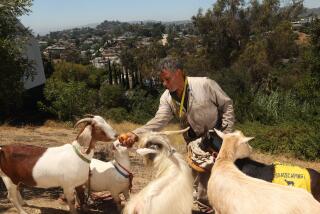A Reprieve : Rescuers Net 60 Goats in Island Herd
- Share via
An animal rights organization netted and corraled 60 wild goats on San Clemente Island Friday on the first day of a rescue operation that seeks to bring half the island’s goats to the mainland for adoption.
The Navy had planned to slaughter the estimated 1,200 to 1,500 goats on the island, which serves as a Navy target range, because they jeopardize the habitats of birds, plants and lizards protected by the U.S. Environmental Protection Act of 1973.
Earlier this month, however, protests by animal rights activists and the intervention of Rep. Bobbi Fiedler (R-Northridge) persuaded Defense Secretary Caspar Weinberger to give the goats a reprieve. The Fund for Animals, a New York-based animal rights organization, has until March 4 to capture and relocate as many of the goats as possible.
On Friday, author Cleveland Amory, president of the fund, boarded a helicopter to observe the operation on the island, located about 60 miles off the coast of San Diego. “I’d like to get 750 . . . to get half of them,” Amory said.
Await Adoption
The goats removed from the island will be transported to four olding areas in California to await adoption, with charges of $25 for the billys and $35 for the nannys. The Navy plans to shoot the goats that are left.
The goats were retrieved with the use of a “net-gun” operated from the fund’s sole helicopter.
Pilot Bill Hales, who works for the fund and flew in its helicopter Friday, helped develop the netting technique, in which a net is stuffed into a metal box with a pipe-like attachment that is joined to a sawed-off shotgun. The gun is pointed at the goat, and the net shoots out, entangling the animal.
Fiedler, who joined Amory for the press conference and also observed the efforts from the air, said “I appealed to Cap Weinberger” for the reprieve because the American people “hate to see useless slaughter take place,” and because the matter had become “a very sensitive political issue.”
After Friday’s round-up, Amory said that “from the look of things, if we can continue to get very high numbers during the early days of the operation, before the animals get too skittish or wary, we should have good success” in meeting their goal of saving half the animals.
More to Read
Sign up for Essential California
The most important California stories and recommendations in your inbox every morning.
You may occasionally receive promotional content from the Los Angeles Times.













